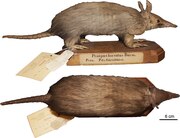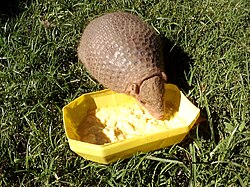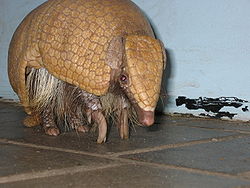Top Qs
Timeline
Chat
Perspective
List of cingulates
Species in mammal order Cingulata From Wikipedia, the free encyclopedia
Remove ads
Cingulata is an order of armored placental mammals. Members of this order are called cingulates, or colloquially, armadillos. They are primarily found in South America, though the northern naked-tailed armadillo is found mainly in Central America and the nine-banded armadillo has a range extending into North America. They are generally found in forests, but also savannas, shrublands, and grasslands. They all follow a similar body plan, and range in size from the pink fairy armadillo, at 11 cm (4 in) plus a 2 cm (1 in) tail, to the giant armadillo, at 100 cm (39 in) plus a 50 cm (20 in) tail. No population estimates have been made for any cingulate species, though the giant armadillo and the Brazilian three-banded armadillo are categorized as vulnerable species.

The twenty-two extant species of Cingulata are divided into two families: Dasypodidae, containing a single genus of nine species in the subfamily Dasypodinae, and Chlamyphoridae, containing thirteen species split between the two genera in the subfamily Chlamyphorinae, three in the subfamily Euphractinae, and three in the subfamily Tolypeutinae. Prior to 2016, all four subfamilies were included in Dasypodidae, with Chlamyphoridae containing only extinct species of glyptodonts.[1][2] Over one hundred extinct Cingulata species have been discovered, though due to ongoing research and discoveries the exact number and categorization is not fixed.[3]
Remove ads
Conventions
The author citation for the species or genus is given after the scientific name; parentheses around the author citation indicate that this was not the original taxonomic placement. Conservation status codes listed follow the International Union for Conservation of Nature (IUCN) Red List of Threatened Species. Range maps are provided wherever possible; if a range map is not available, a description of the cingulate's range is provided. Ranges are based on the IUCN Red List for that species unless otherwise noted. All extinct species or subspecies listed alongside extant species went extinct after 1500 CE, and are indicated by a dagger symbol "†".
Remove ads
Classification
Summarize
Perspective

The order Cingulata consists of two families, Dasypodidae and Chlamyphoridae. Dasypodidae contains nine species in a single genus, while Chlamyphoridae contains thirteen species in eight genera, divided into three subfamilies. Many of these species are further subdivided into subspecies. This does not include hybrid species or extinct prehistoric species.
Family Dasypodidae
- Subfamily Dasypodinae
- Genus Dasypus (long-nosed armadillos): nine species
Family Chlamyphoridae
- Subfamily Chlamyphorinae
- Genus Calyptophractus (greater fairy armadillo): one species
- Genus Chlamyphorus (pink fairy armadillo): one species
- Subfamily Euphractinae
- Genus Chaetophractus (hairy armadillos): two species
- Genus Euphractus (six-banded armadillo): one species
- Genus Zaedyus (pichi): one species
- Subfamily Tolypeutinae
- Genus Cabassous (naked-tailed armadillos): four species
- Genus Priodontes (giant armadillo): one species
- Genus Tolypeutes (three-banded armadillos): two species
Remove ads
Cingulates
Summarize
Perspective
The following classification is based on the taxonomy described by the reference work Mammal Species of the World (2005), with augmentation by generally accepted proposals made since using molecular phylogenetic analysis.[4]
Dasypodidae
Subfamily Dasypodinae
Chlamyphoridae
Subfamily Chlamyphorinae
Subfamily Euphractinae
Subfamily Tolypeutinae
Remove ads
References
Sources
Wikiwand - on
Seamless Wikipedia browsing. On steroids.
Remove ads







































